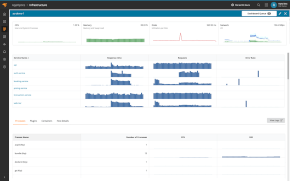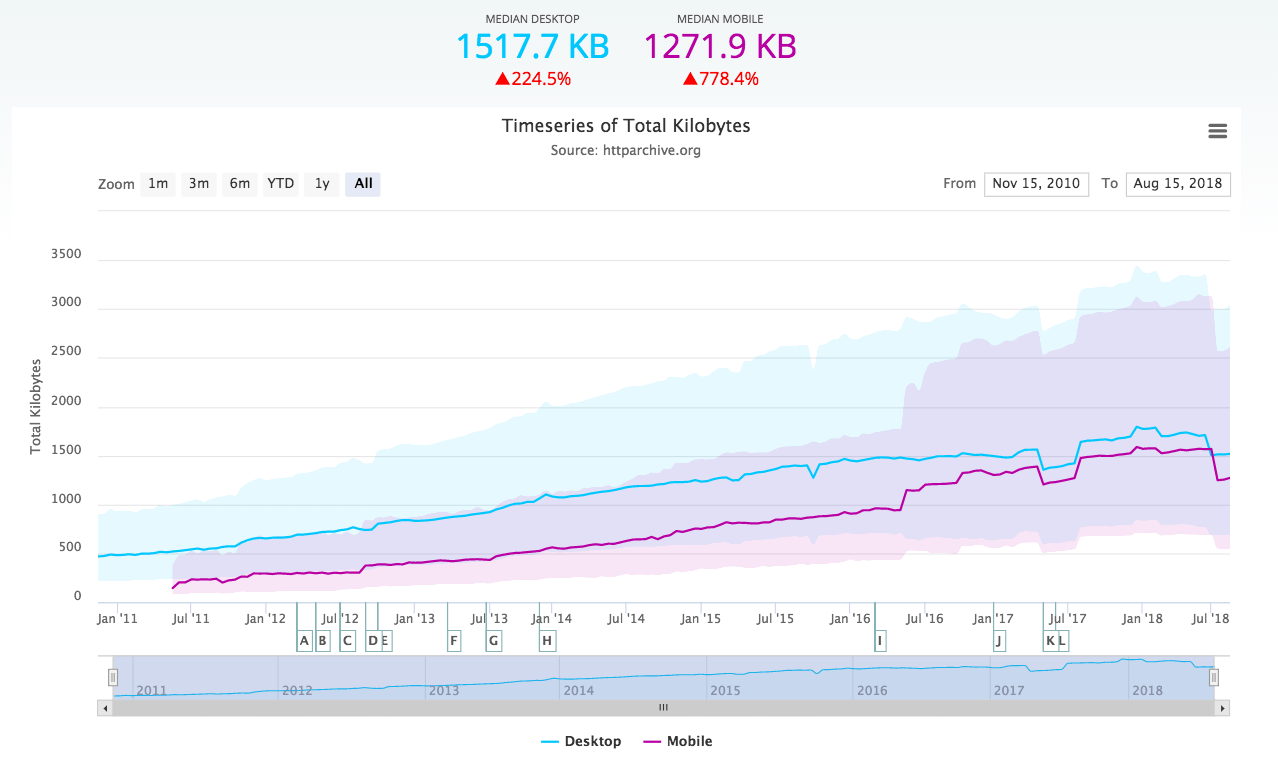Code names can be about secrecy, but when it comes to software development, it’s usually not so much about secrecy as it is about the convenience of having a name for a specific version of the software. It can be very practical to have a unique identifier for a project to get everyone on the same page and avoid confusion. It can also be a great way to build excitement and cohesion in a development team.
And we want to name our darlings, don’t we?
So what kind of code names are developers out there coming up with? Here is a collection of code names for software products from companies like Google, Microsoft, Apple, Canonical, Red Hat, Adobe, Mozilla, Automattic and more. We tried to give some background information wherever possible. You’ll notice that some code name schemes are definitely more out there than others.
Mozilla Code Names
Mozilla has based most of the code names for different Firefox versions on parks.
An interesting aside is that Mozilla itself was originally the internal code name at Netscape for its Netscape Navigator project.
- Phoenix – Firefox 1.0
- Deer Park – Firefox 1.5
- Bon Echo – Firefox 2
- Gran Paradiso – Firefox 3
- Shiretoko – Firefox 3.5
- Namoroka – Firefox 3.6
Microsoft Code Names
Microsoft has a ton of products, and code names for most of them. When it comes to Windows, Microsoft seems largely obsessed with location names, with a few exceptions.
- Janus – Windows 3.1
- Snowball – Windows for Workgroups 3.11
- Chicago – Windows 95
- O’Hare – First version of Internet Explorer
- Memphis – Windows 98
- Daytona – Windows NT 3.5
- Cairo – Windows NT 4.0
- Whistler – Windows XP
- Longhorn – Windows Vista
- Vienna – Windows 7
- Blue – Windows 8.1
- Threshold – Windows 10 (RTM and 1511)
- Redstone – Windows 10 (versions 1607, 1703, 1709, 1803 and 1809)
- Santorini- Windows !0x (Cancelled)
- Sun Valley – Windows 11
Canonical Code Names
Code names for Ubuntu versions always follow the pattern “adjective + animal”. The first Ubuntu release was called Warty Warthog because it was created in a short period of time and there wasn’t much time for polish. Canonical wanted to keep using “hog” in the version names, but soon abandoned that (after Hoary Hedgehog). If they hadn’t, Breezy Badger would have been code named Grumpy Groundhog.
Note also that as of Breezy Badger, the code names have been in alphabetical order.
- Warty Warthog – Ubuntu 4.10
- Hoary Hedgehog – Ubuntu 5.04
- Breezy Badger – Ubuntu 5.10
- Dapper Drake – Ubuntu 6.06
- Edgy Eft – Ubuntu 6.10
- Feisty Fawn – Ubuntu 7.04
- Gutsy Gibbon – Ubuntu 7.10
- Hardy Heron – Ubuntu 8.04
- Intrepid Ibex – Ubuntu 8.10
- Jaunty Jackalope – Ubuntu 9.04
- Karmic Koala – Ubuntu 9.10
- Lucid Lynx – Ubuntu 10.04
- Maverick Meerkat – Ubuntu 10.10
- Natty Narwhal – Ubuntu 11.04
- Oneiric Ocelot – Ubuntu 11.10
- Precise Pangolin – Ubuntu 12.04
- Quantal Quatzal – Ubuntu 12.10
- Raring Ringtail – Ubuntu 13.04
- Saucy Salamander – Ubuntu 13.10
- Trusty Tahr – Ubuntu 14.04
- Utopic Unicorn – Ubuntu 14.10
- Vivid Vervet – Ubuntu 15.04
- Wily Werewolf – Ubuntu 15.10
- Xenial Xerus – Ubuntu 16.04
- Yakkety Yak – Ubuntu 16.10
- Zesty Zapus – Ubuntu 17.04
- Artful Aardvark – Ubuntu 17.10
- Bionic Beaver – Ubuntu 18.04
- Cosmic Cuttlefish – Ubuntu 18.10
- Disco Dingo – Ubuntu 19.04
- Eoan Ermine – Ubuntu 19.10
- Focal Fossa – Ubuntu 20.04
- Groovy Gorilla – Ubuntu 20.10
- Hirsute Hippo – Ubuntu 21.04
- Impish Indri – Ubuntu 21.10
- Jammy Jellyfish – Ubuntu 22.04
- Kinetic Kudu – Ubuntu 22.10
- Lunar Lobster – Ubuntu 23.04
Apple Code Names
Just like Microsoft, Apple has several products, and code names for basically all of them. We focused on Mac OS. The influences for Apple’s Mac OS code names are pretty obvious. For a while they were mostly musical terms, and as of Mac OS X, the focus switched to big cats.
Fun little anecdote: System 7.5 was code named Mozart, but also Capone. Why Capone? Because like the famous gangster, it was meant to rule over Chicago (Windows 95).
We also have to mention Apple’s code name for A/UX (Apple Unix) 1.0: Pigs in Space.
- Harmony – Mac OS 7.6
- Tempo – Mac OS 8.0
- Bride of Buster – Mac OS 8.1
- Allegro – Mac OS 8.5
- Sonata – Mac OS 9
- Fortissimo – Mac OS 9.1
- Moonlight – Mac OS 9.2
- Cheetah – Mac OS X 10.0
- Puma – Mac OS X 10.1
- Jaguar – Mac OS X 10.2
- Panther – Mac OS X 10.3
- Tiger – Mac OS X 10.4
- Leopard – Mac OS X 10.5
- Snow Leopard – Mac OS X 10.6
- Lion – Mac OS X 10.7
- Mountain Lion – OS X 10.8
- Mavericks – OS X 10.9
- Yosemite – OS X 10.10
- El Capitan – OS X 10.11
- Sierra – macOS 10.12
- High Sierra – macOS 10.13
- Mojave – macOS 10.14
- Catalina – macOS 10.15
- Big Sur – macOS 11
- Monterey – macOS 12
- Ventura – macOS 13
Automattic Code Names
Starting after WordPress 1.0, Automattic has code named most WordPress releases after well-known jazz musicians.
- Mingus – WordPress 1.2
- Strayhorn – WordPress 1.5
- Duke – WordPress 2.0
- Ella – WordPress 2.1
- Getz – WordPress 2.2
- Dexter – WordPress 2.3
- Brecker – WordPress 2.5
- Tyner – WordPress 2.6
- Coltrane – WordPress 2.7
- Baker – WordPress 2.8
- Carmen – WordPress 2.9
- Thelonious – WordPress 3.0
- Reinhardt – WordPress 3.1
- Gershwin – WordPress 3.2
- Sonny – WordPress 3.3
- Green – WordPress 3.4
- Elvin – WordPress 3.5
- Oscar – WordPress 3.6
- Basie – WordPress 3.7
- Parker – WordPress 3.8
- Smith – WordPress 3.9
- Benny – WordPress 4.0
- Dinah – WordPress 4.1
- Powell – WordPress 4.2
- Billie – WordPress 4.3
- Clifford – WordPress 4.4
- Coleman – WordPress 4.5
- Pepper – WordPress 4.6
- Vaughan – WordPress 4.7
- Evans – WordPress 4.8
- Tipton – WordPress 4.9
- Bebo – WordPress 5.0
- Betty – WordPress 5.1
- Jaco – WordPress 5.2
- Kirk – WordPress 5.3
- Adderley – WordPress 5.4
- Eckstine – WordPress 5.5
- Simone – WordPress 5.6
- Esperanza – WordPress 5.7
- Tatum – WordPress 5.8
- Arturo – WordPress 6.0
Google Code Names
Someone at Google clearly has a sweet tooth. All Android code names are pastries or desserts. (For those who wonder what FroYo is, it’s short for frozen yogurt.)
- Cupcake – Android 1.5
- Donut – Android 1.6
- Eclair – Android 2.0/2.1
- FroYo – Android 2.2
- Gingerbread – The update after FroYo
- Ice Cream Sandwich – Android 4.0
- Jelly Bean – Android 4.1-4.3
- KitKat – Android 4.4
- Lollipop – Android 5.0-5.1
- Marshmallow – Android 6.0
- Nougat – Android 7.0-7.1
- Oatmeal Cookie (Oreo) – Android 8.0-8.1
- Pistachio Ice Cream (Pie) – Android 9
- Quince Tart – Android 10
- Red Velvet Cake – Android 11
- Snow Cone – Android 12
- Tiramisu – Android 13
- Upside Down Cake – Android 14
Adobe Code Names
Adobe’s code names for Photoshop largely seem to be movie related in one form or another, with names of movie characters, movie titles, and other references, some definitely more obscure than others.
- Fast Eddy – Photoshop 2.0
- Tiger Mountain – Photoshop 3.0
- Big Electric Cat – Photoshop 4.0
- Strange Cargo – Photoshop 5.0
- Venus in Furs – Photoshop 6.0
- Liquid Sky – Photoshop 7.0
- Dark Matter – Photoshop CS
- Space Monkey – Photoshop CS2
- Red Pill – Photoshop CS3
- Stonehenge – Photoshop CS4
- White Rabbit – Photoshop CS5
- Superstition – Photoshop CS6
- Lucky 7 – Photoshop CC
- Single Malt Whiskey Cat – Photoshop CC 2014
- Dedicated to Thomas and John Knoll – Photoshop CC 2015 1, 1.2
- Haiku – Photoshop CC 2015.5, 5.1
- Big Rig – Photoshop CC 2017
- White Lion – Photoshop CC 2018
- B Winston – Photoshop CC 2019
Fedora Code Names
Fedora started off relatively thematic, with the code names for Fedora Core 1 through 5 all being in some way related to alcohol (wine or beer). After that, the relationships between the code names get much less consistent.
Update: Fedora uses a naming scheme where a new release has to have a relationship with the previous release. More info on their guidelines page.
- Yarrow – Fedora Core 1
- Tettnang – Fedora Core 2
- Heidelberg – Fedora Core 3
- Stentz – Fedora Core 4
- Bordeaux – Fedora Core 5
- Zod – Fedora Core 6
- Moonshine – Fedora 7
- Werewolf – Fedora 8
- Sulphur – Fedora 9
- Cambridge – Fedora 10
- Leonidas – Fedora 11
- Constantine – Fedora 12
- Goddard – Fedora 13
- Laughlin – Fedora 14
- Lovelock – Fedora 15
- Verne – Fedora 16
- Beefy Miracle – Fedora 17
- Spherical Cow – Fedora 18
- Schrödinger’s Cat – Fedora 19
- Heisenbug – Fedora 20
- Twenty One – Fedora 21
Red Hat Linux Code Names
The geek presence is strong here. Note for example the (original) Battlestar Galactica reference for RHL 5.2 and 5.9: Apollo and Starbuck. Or it could be a coincidence, because there are many literary and mythical references here. For example, Starbuck is also a character in the novel Moby-Dick, The Sea-Wolf is a Jack London novel, and so on. Fun aside, one RHL version shares its name with a Mozilla product: Thunderbird.
- Mother’s Day – RHL 1.0
- Picasso – RHL 3.0.3
- Colgate – RHL 4.0
- Vanderbilt – RHL 4.1
- Biltmore – RHL 4.2
- Thunderbird – RHL 4.8
- Mustang – RHL 4.9
- Hurricane – RHL 5.0
- Manhattan – RHL 5.1
- Apollo – RHL 5.2
- Starbuck – RHL 5.9
- Hedwig – RHL 6.0
- Cartman – RHL 6.1
- Piglet – RHL 6.1.92
- Zoot – RHL 6.2
- Pinstripe – RHL 6.9.5
- Guinnes – RHL 7.0
- Fisher – RHL 7.0.90
- Wolverine – RHL 7.0.91
- Seawolf – RHL 7.1
- Roswell – RHL 7.1.93
- Enigma – RHL 7.2
- Skipjack – RHL 7.2.91
- Valhalla – RHL 7.3
- Limbo – RHL- 7.3.29
- Psyche – RHL 8.0
- Shrike – RHL 9
- Severn – RHL 9.0.93
Debian Code Names
All Debian releases are code named after character names from the film Toy Story. Remember Sid, the emotionally unstable, toy-destroying kid next door? That’s the permanent name for Debian’s unstable development distribution.
- Buzz – Debian 1.1
- Rex – Debian 1.2
- Bo – Debian 1.3
- Hamm – Debian 2.0
- Slink – Debian 2.1
- Potato – Debian 2.2
- Woody – Debian 3.0
- Sarge – Debian 3.1
- Etch – Debian 4.0
- Lenny – Debian 5.0
- Squeeze – Debian 6.0
- Wheezy – Debian 7.0
- Jessie – Debian 8.0
- Stretch – Debian 9.0
- Buster – Debian 10.0
- Bullseye – Debian 11
Final Words (Not in Code)
It’s not just software developers who are fond of code names. You’ll find code names wherever there’s some form of research and development going on. For example, Intel and AMD have code names for their processors, Microsoft has code names for each iteration of Xbox 360, Apple has code names for its various computers, and so on.
What we find interesting is the amount of creativity many put into these code names, often revealing cultural references and other obscure interests of its developers.
Want More?
Can’t get enough geekiness? On the theme of code names, take a look at project “Natick” the Microsoft underwater datacenter. It looks as if taken straight from a 007-movie! Also, be sure to check out this massive collection of early computers.
Note: This article first appeared on this blog back in 2010, and we have slightly touched up the content in January 2023.

























